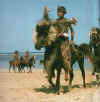
Bridles, bits and head collars
Tribal riders in the Sunda Islands of the South Pacific. Click on photo to enlarge.
 |
Bridles, bits and head collars Tribal riders in the Sunda Islands of the South Pacific. Click on photo to enlarge. |
Long Rider Comments
| Here is a useful gadget for
measuring the correct size of bit for a horse!
Robert Wauters |
| Bridle
- I used a
leather Queensland station bridle, made by Les Wilkins in Hawarden, New
Zealand. It came with a rope halter underneath and a long lead-rope
knotted around the neck. I recommend putting clips on the end of the
reins so they can be easily removed when grazing, managing gates, etc.
Mary Pagnamenta |
|
A hackamore is the best thing for travel of
this type because the horse can eat and drink more freely. (A
horse covering travel miles will need to graze at least six hours each
day, and this needs to be scattered throughout the day, not all in one
lump.) For Cacho a bosal worked great, but Shawnee didn't respond
well to it. I had only recently put her under saddle, and she is
easily distracted, so I needed some leverage to get her attention from
time to time in dangerous situations, for example, around traffic.
Unfortunately the long shank on most hackamores inhibited her already
nervous grazing. I found a quick-stop that worked just great for
her.
Lisa Wood |
|
Bridles. Nylon or leather
endurance bridles with removable bits. Woven webbing reins (which give
grip in the rain) and clips to remove them from the bit always.
Julian Ross |
|
Headcollars: A nylon
headcollar, the cheapest, worked very well for six months and is easily
repaired. There are straps so you can attach the bit directly onto
it.
Laura Bougault |
| Mongolian
bridles and halters are usually made of dried, but unprocessed, leather -
they don't last longer than maybe a year or two. We were always
carrying bits and pieces of leather with us to repair the hobbles (tschodor),
whips (taschoor) and the leather ropes on the saddle. Once we had a
bigger problem with the saddle straps, and the Mongolians helped us.
They are extremely clever and resourceful in repairing things.
Evelyn Landerer |
| For convenience
I use webbing bridles. Saves time not having to oil them, and they
are easy to scrub when there is a bit of water around.
Steve Nott |
| For the
headcollar, bridle, reins and leading ropes I use simply 3" diameter
Kevlar, seven metres long, with a mountaineering security snap. (I
have used these daily for three years without any maintenance.)
Jean-Claude Denys |
Items of Interest
| This Australian halter-bridle looks ideal for Long Riders. It is available from hue-hott.de, catalogue number AZ04. |
| Saddles, saddle-pads & saddle-bags | Pack saddles | Horse-shoes & hoof care | ||
| Horse training | Tents | Solar power & laptops | Clothing | Camping equipment |
|
Click here
to see the world's largest collection |